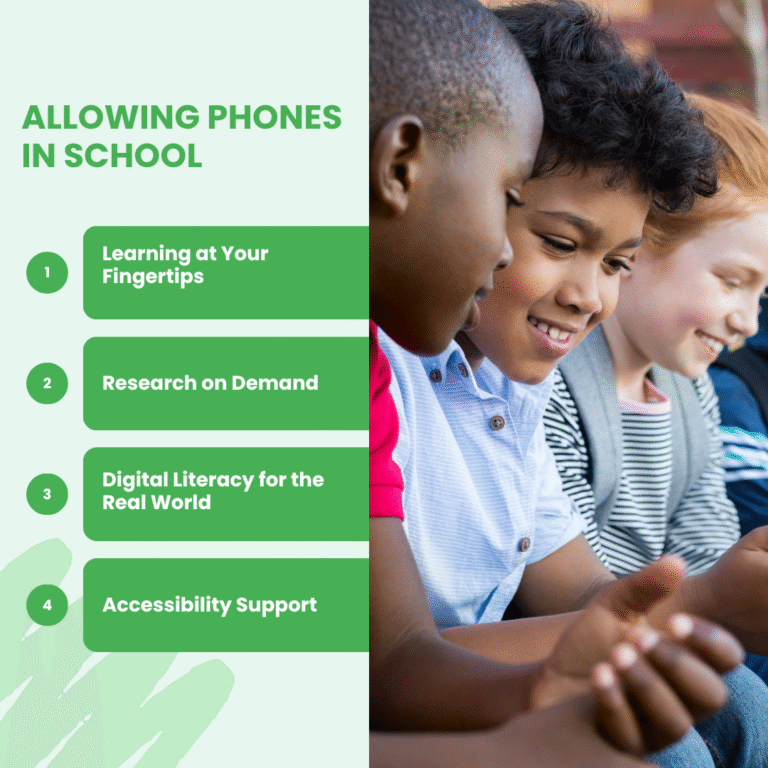By Kacy Kaiser
The bell rings, and instead of opening textbooks, many students reach for their phones. This scene plays out in classrooms worldwide, sparking heated debates among educators, parents, and policymakers. Should phones be allowed in school? It’s a question that touches on learning, safety, social development, and preparing students for their future.
This isn’t just about rules—it’s about finding the right balance in a world where technology is everywhere. Some see phones as powerful learning tools, while others view them as dangerous distractions. The truth, as you might expect, lies somewhere in between.
Let’s explore both sides of this debate, looking at research, expert opinions, and global approaches to help schools and families make informed decisions about phones in educational settings.
How We Got Here: Phones in the Classroom
Remember when passing notes was the biggest classroom distraction? Those days are long gone. The first mobile phones in schools appeared in the late 1990s, but they were rare and primarily used for emergency calls after school hours.
By the mid-2000s, as smartphones became more common, schools began implementing strict bans. The typical policy was simple: phones stay in lockers or backpacks, turned off until the final bell.
The pandemic changed everything. Remote learning pushed schools to embrace technology like never before. Students used phones to attend virtual classes, complete assignments, and stay connected during isolation. When in-person learning resumed, many schools found it difficult to put the technology genie back in the bottle.
Today, we’re at a crossroads. Some schools are doubling down on phone bans, while others are exploring ways to integrate these devices into learning. The conversation has shifted from “if” to “how” and “when” phones should be used in educational settings.
The Case for Allowing Phones in School

Learning at Your Fingertips
Modern smartphones pack more computing power than the machines that sent astronauts to the moon. Students can access educational apps, reference materials, and interactive learning tools instantly.
“I’ve seen struggling students bloom when they can use apps that match their learning style,” says Maria Chen, a high school science teacher in California. “One student used a 3D anatomy app to finally understand the circulatory system after traditional methods failed.”
Educational apps can provide personalized learning experiences that textbooks simply can’t match. Students can progress at their own pace, get immediate feedback, and engage with material in ways that work for them.
Research on Demand
Need to look up a historical date? Translate a foreign phrase? Check a scientific formula? Smartphones put the world’s knowledge in students’ pockets.
In a 2021 survey of middle school teachers, 68% reported that when properly guided, students who could quickly research topics during discussions showed deeper engagement with the material. Quick access to information can enrich classroom conversations and encourage fact-checking habits.
Safety and Communication
For many parents, phones provide peace of mind. They can reach their children during emergencies and vice versa.
“After the tornado warning last year, our phone policy saved us from panic,” explains Principal Robert Jackson from Westfield Middle School. “Students could text their parents they were safe, which prevented our office from being overwhelmed with calls.”
Beyond natural disasters, phones can help during medical emergencies, allowing students to call for help or access medical information quickly.
Digital Literacy for the Real World
Students will use technology throughout their lives. Learning to use phones responsibly in school can prepare them for the workplace, where they’ll need to manage digital distractions and use technology productively.
“We’re not doing kids any favors by creating a phone-free bubble,” argues digital education specialist Dr. Amara Wilson. “They need guided practice using these tools responsibly before they enter college or the workforce.”
Accessibility Support
For students with disabilities, smartphones can be life-changing accessibility tools. Text-to-speech features help students with reading difficulties, while visual aids assist those with hearing impairments.
Jake, a high school junior with dyslexia, shares: “My phone reads text aloud to me and helps me organize my thoughts. Without it, I’d struggle to keep up with assignments.”
The Case Against Phones in School
The Distraction Factor
The average teen checks their phone 86 times per day. Each notification pulls attention away from learning, and research shows it takes 23 minutes to fully refocus after an interruption.
A 2020 study published in Educational Psychology found that students who had phones visible during lessons scored 20% lower on comprehension tests compared to those with phones put away.
“I can literally see the moment I lose them,” says English teacher Marcus Williams. “A phone buzzes, and suddenly half the class is mentally elsewhere, even if they don’t pick up the device.”
Academic Integrity Concerns
Phones make cheating easier than ever. Students can discreetly search for test answers, share information during exams, or use AI tools to complete assignments.
“We caught students using group chats to share answers during tests,” reports high school administrator Susan Chen. “It’s becoming harder to ensure work represents a student’s own knowledge.”
Cyberbullying and Social Pressure
When phones are allowed in school, cyberbullying can happen right under teachers’ noses. A 2022 survey found that 59% of teen cyberbullying incidents occurred during school hours.
Social media creates constant pressure to maintain online personas. Students compare themselves to carefully curated images, leading to anxiety and self-esteem issues.
“The lunchroom used to be for socializing,” observes school counselor David Martinez. “Now I see tables of kids scrolling through Instagram instead of talking to each other. They’re physically together but socially isolated.”
Mental Health Impact
Growing evidence links excessive phone use with anxiety, depression, and sleep problems in teens. A study in the Journal of Adolescent Health found that students who used phones during school breaks reported higher stress levels than those who engaged in phone-free activities.
“We saw immediate improvements in student mood and energy when we created phone-free zones,” reports Principal Leila Johnson. “Kids started playing games, talking, and laughing more.”
The Digital Divide
Not every student has the latest smartphone or unlimited data. When educational activities require phones, students from lower-income families may be disadvantaged.
“It creates an invisible hierarchy,” explains sociology professor Dr. James Thompson. “Students notice who has the newest iPhone and who doesn’t. It can reinforce socioeconomic divisions in the classroom.”
Phone Policies Around the World
Different countries have taken vastly different approaches to phones in schools:
France implemented one of the strictest nationwide bans in 2018, prohibiting phones for students under 15. Early research suggests improvements in student focus and social interaction, though long-term studies are still ongoing.
The United Kingdom recently encouraged schools to ban phones, with the Department for Education issuing guidance in 2023 recommending phone-free school days.
Finland, known for its excellent education system, takes a different approach. Many Finnish schools integrate phones as learning tools while teaching digital citizenship from an early age.
Australia has varied policies by state, with some implementing total bans and others allowing educational use. New South Wales banned phones in primary schools in 2019 and expanded the ban to high schools in 2023.
United States policies vary widely by district. Some schools require phones to be kept in lockers, while others use pocket holders in classrooms. Some progressive districts have created “phone zones” where usage is permitted during specific times.
Japan generally prohibits bringing phones to school, though exceptions are made for students with long commutes for safety reasons.
What the Experts Say
Education researchers remain divided on the issue, but most agree that how phones are managed matters more than whether they’re allowed.
Dr. Michael Thompson, education psychologist, explains: “The research doesn’t support absolute positions. What works is thoughtful integration with clear boundaries. Students need to learn when technology helps and when it hinders.”
A 2022 meta-analysis of 39 studies found that phone bans showed modest academic benefits in elementary schools but mixed results in high schools. The researchers noted that teaching phone management skills produced better long-term outcomes than outright prohibition.
“We’re asking the wrong question,” suggests digital education researcher Dr. Lisa Chen. “Instead of ‘Should phones be allowed?’ we should ask ‘How do we teach students to use technology mindfully?'”
Finding Balance: Recommendations for Schools and Families
For Schools
Create clear, age-appropriate policies. Elementary students may need stricter limits than high schoolers who are preparing for adult independence.
Consider designated phone times and spaces. Some schools allow phone use during lunch or in specific “tech zones” while maintaining phone-free classrooms.
Teach digital citizenship. Include lessons on responsible technology use, privacy, and digital well-being in the curriculum.
Provide phone storage solutions. Pocket charts or lockable pouches can help students resist the temptation to check devices during class.
Be consistent with enforcement. Rules that are applied unevenly create confusion and resentment.
For Parents
Talk with your children about responsible phone use. Discuss both the benefits and risks of smartphones.
Set expectations for school phone use. Make sure your child understands and respects school policies.
Model healthy technology habits. Children learn from watching adults manage their own screen time.
Parents who want more control over their child’s phone usage can consider tools like the MMGuardian Kids Phone, which offers robust parental controls to ensure responsible smartphone habits while still allowing necessary communication.
For Policymakers
Base guidelines on research, not fear or hype. Evidence-based approaches yield better results than reactive policies.
Consider developmental stages. What works for teenagers may not be appropriate for younger children.
Provide resources for digital literacy education. Schools need support to effectively teach responsible technology use.
Evaluate outcomes regularly. Phone policies should be assessed and adjusted based on their actual impact on learning and well-being.
Finding the Right Answer for Your School
There’s no one-size-fits-all solution to phones in schools. The right approach depends on student age, school culture, available resources, and community values.
What’s clear is that simply banning or allowing phones without thoughtful implementation isn’t enough. Students need guidance to develop healthy relationships with technology that will serve them throughout their lives.
The most successful schools approach this issue with flexibility and purpose. They recognize that phones, like any tool, can be used well or poorly. By teaching students when and how to use these powerful devices appropriately, schools prepare them not just for tests, but for life in a digital world.
The question isn’t really whether phones should be allowed in school—it’s how we can help students learn to use technology as a tool rather than being controlled by it. That’s a lesson worth teaching.






